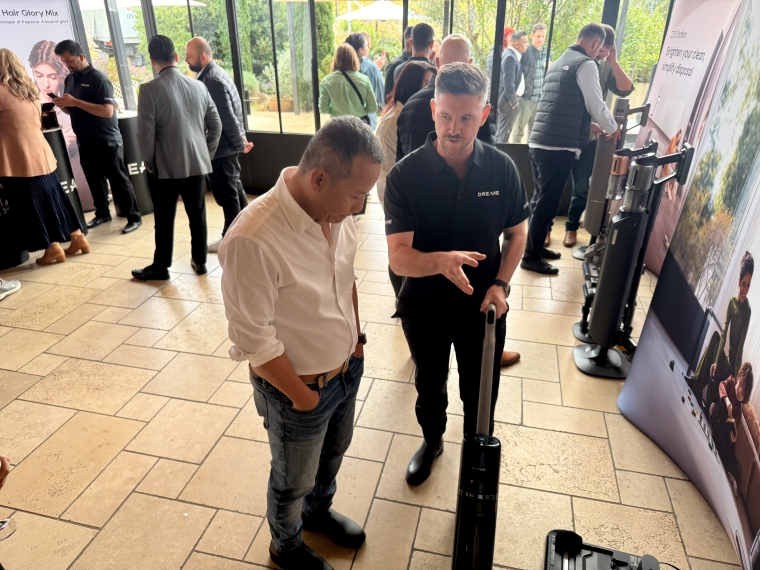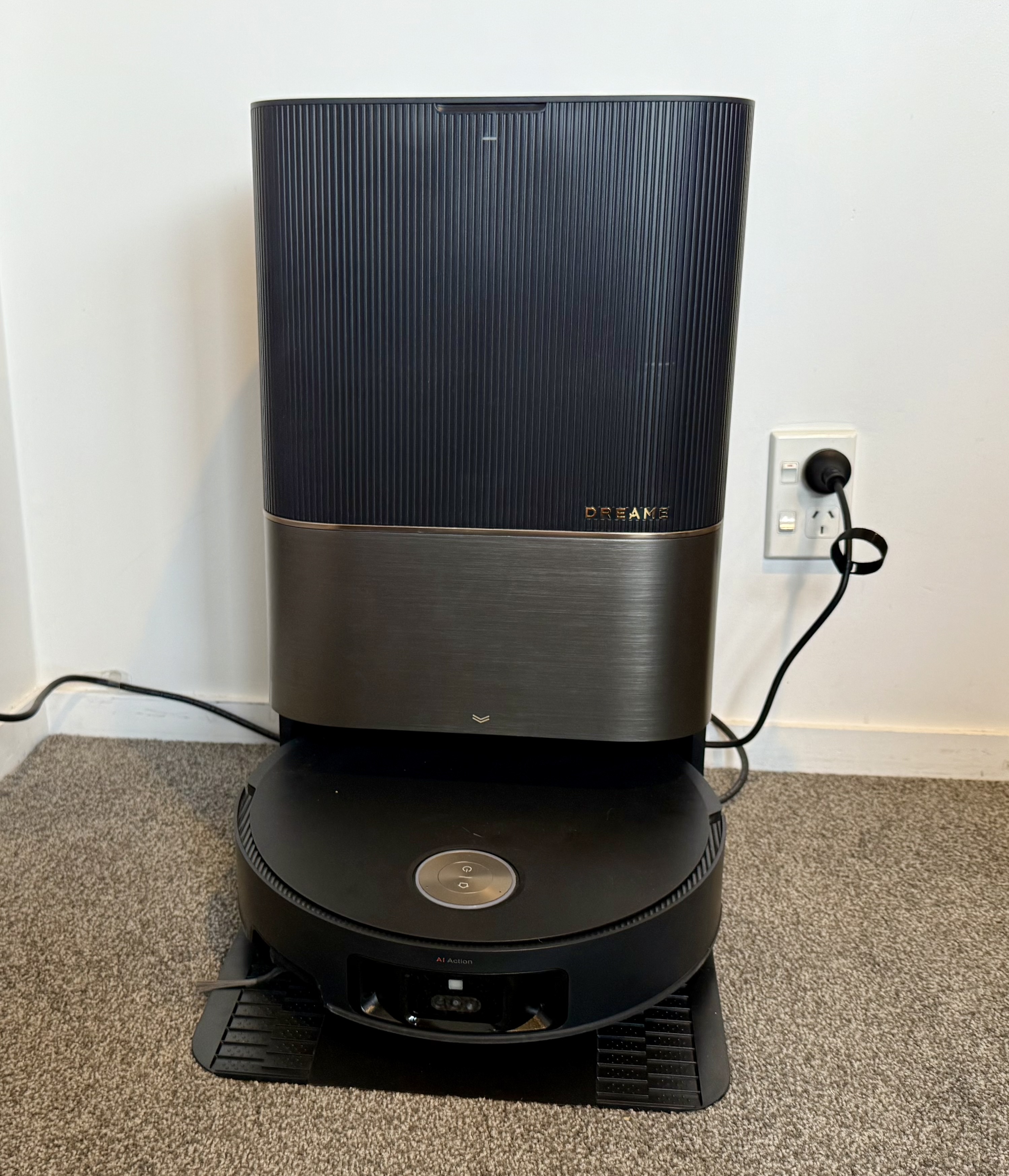
Chinese household appliance maker Dreame Technology decided to kick off its New Zealand operations properly, having tested the local waters since last year. Dreame did so on Waiheke, a lovely location that can be difficult to reach when storms wreak havoc with event schedules.
That is what happened, as strong winds and heavy rain caused ferry delays for the arrival of product and sales people from the big retailers wanting to check out Dreame’s new offerings for the New Zealand market.
It was quite an array of products as well. On display were Dreame’s range of robo, stick and upright vacuums. Plus a robo-mower, which Waiheke vineyard owners expressed interested in, as it can navigate soft soil and narrow rows being lightweight and compact.
The range of products was selected for the Australian and New Zealand markets specifically. We have huge houses and big sections, unlike in China where robots for pool skimming and vacuuming aren’t quite as much in demand in cities with mostly high-rise housing.
There were other items as well, like very space-age looking quiet hair dryers, but the one device that grabbed the attention of the crowd was the robotic window clear. Fill it up with glass cleaner, put it onto a window and it sticks to it like a limpet while cleaning it, going up and down. A technical tour de force. It would be curious to test drive one to see how practical it is to use.
High-tech, robotic appliances have been around for a while so how does a new entrant differentiate itself in the market? Samira Tang, Dreame’s communications manager, explained the research being done ahead of the launch, saying Kiwi homes have more carpeted areas than other countries - but new homes often go for mostly hardwood floors.
Dreame reckons they have the right gear for our mixed floor surfaces, unlike competitors that focus on universal designs. See below for a hands-on test of the flagship X50 Ultra robovac which features Dynamic Surface Adaptation, and which can raise the brushes and mops when it encounters carpets.
Yes, cleaning tech is quite nerdy and geeky, and Dreame prides itself on employing lots of engineers to build better robots. Not just that, companies like Dreame get independent testing done on their gear to back up the claims they make, and have a bundle of certifications from the likes of Frost & Sullivan and Germany’s TÜV SÜD.
It may come as a surprise, but in-store retail seems to be where it’s at in New Zealand rather than online, for appliances. Tang cited the NZ Post Annual eCommerce Review 2024, which found in-store retail spending still accounts for 89 per cent of the total in New Zealand.
You learn interesting things talking to retailers. For example, a high-ish retail price point isn’t necessarily a difficult sales proposition, even in the current weak economy. Instead, it can mean bigger margins so that large sales volumes aren’t needed.
For shop floors, retailers obviously need demonstrators. That’s one thing, but retailers are keen on getting supporting material like the raised box to show off the jumping Dreame X50 Ultra robovacuum. It can climb over obstacles up to 42-60 mm with its ProLeap retractable legs, like so:
What is Dreame then?
Headquartered in Suzhou, Jiangsu province, Dreame Technology is a relatively young company, established in 2015 by Yu Hao.
It’s been active in Australia before heading over to New Zealand last year, and was started by aeroplane engineers becoming obsessed with creating high-speed digital electric motors that spin at 150,000 to 200,000 revolutions per minute.
Those high motor RPMs mean better suction from turbines, which is what you want for robotic vacuums.
In Dreame’s background is China’s gigantic smartphone and electronics conglomerate Xiaomi. Dreame Technology is part of Xiaomi’s ecological chain of companies. The companies in question receive minority investment from Xiaomi, but operate independently and often with similar products - Dreame competes with robo-vac makers Ecovacs and Roborock, and even Xiaomi which also has its own brand of dust-suckers.
A large number of companies are part of the Xiaomi Ecological Chain, which makes high-tech products of all sorts; one company, Smartmi, works with Chery to produce electric cars. The longer story here is that the Xiaomi Ecological Chain is a sprawling, enormous business empire that spans manufacturing, wholesale and distribution, and retail.
Ali Baba’s Jack Ma has also invested in Dreame Technology. Why the name Dreame? From what I can tell, it’s partly due to the Chinese name, 追觅, which is something like “zhui me” and means “to search” or “to seek”. Somewhere along the line “dream” entered into the branding process, and Dreame Technology was born.

Dreame X50 Ultra, a robovac loaded with tech
How does Dreame’s tech work then? The abovementioned X50 Ultra has been vacuuming and mopping floors around my house for about three weeks, and it’s a device that comes with a dizzying array of technology.
The X50 Ultra is very much a premium device: the New Zealand retail price is $3499 including GST. That buys the robot itself with accessories like two dust bags and a starter amount of cleaning fluid for the mops; and the base station which stores dust emptied out from the robovac, as well as the water for mopping.
It’s quite a big base station that’s 590 mm tall, 457 mm deep and 340 mm wide; the X50 Ultra itself is a normal, round vacuum robot size, and with the Versalift sensor down, it’s just 89 mm tall. When it doesn’t need to clean under furniture, the X50 Ultra pops up the Versalift sensor and becomes 111 mm tall.
That sensor uses direct time of flight light detection and ranging (now you know what the abbreviations DToF LiDAR mean). This is used to map distances by bouncing light pulses off obstacles. DToF LiDAR is advanced tech; on the X50 Ultra it’s supplemented with artificial intelligence for three dimensional mapping, and an LED light comes on in the dark to help the robot see where to go.
The X50 Ultra is said to be able to vacuum up to 205 m2 between charges, and has 220 minutes of runtime from a 5200 mAh battery. This on the quiet suction setting. The spaces I tested in weren’t that big, but are partly carpeted which makes for harder work for the robovac. Even then the X50 Ultra never ran out of charge and had to return to the base station for an electricity top up in the middle of a job.
In action, the X50 Ultra really sucks. Ho ho, I crack myself up, but either way, the Dreame device is rated at 20 kilo-Pascal maximum suction power. A couple of years ago, I tried robovacs from competing brands, and they managed 8-10 kPa which seemed impressive then.
It's difficult for humans to relate to kPa numbers, but the X50 Ultra is very powerful in that respect, yet quiet at just 58 dB. And yes, it jumps with the ProLeap system so as to overcome obstacles like ranch sliders that would stop other robovacs.
The mops can be left behind in the base station for carpet work, or when installed, they can be raised about 10 mm to prevent a soggy rug. Mopping itself works well, but the algorithm can be a bit strange at times. Occasionally the X50 Ultra would only do half of the mopping required, scoot off and do some more vacuuming, and then come back to mop the rest.
Mop cleaning with boiling hot water, and drying happens automatically, and there’s an ultraviolet sterilisation light that TÜV SÜD says kills most (99.9999%) of nasty-sounding bacteria which will appeal to germphobes.
Here’s a pro-tip though: empty the dirty mopping water container after each run of the X50 Ultra. You can guess how I learnt that. Yuck.
Other than that, it’s impossible not to be impressed by the amount of clever tech and thinking that’s gone into X50 Ultra. The robot has a little brush that it can poke out (if set to do so) to get close and sweep near skirting boards, and the mops can swing out too, to reach under cupboards and fridges (a little at least). That is the engineering you pay for, after all.
Even the dual brush system is designed to handle long hair without tangling, and the X50 Ultra can also take pictures of your pets so as to recognise them. No more accidental vacuuming attempts of sleeping cats and dogs then. Apparently there’s Smart Pet Deodorising Foam Wash Technology built into Dreame’s floor washing machines, “which instantly dissolves stubborn stains and pet urine while sterilising and eliminating odours”.
I was quite relieved that I didn’t have to try out that particular cleaning up after pets tech.
Does the X50 Ultra do a perfect job? It does a very good job, but you realise how excellent humans are at cleaning still, even when compared to AI powered robots. Some bigger pieces of detritus near the edges of skirting boards and raised flooring can be missed by the X50 Ultra. If that happens, you just tell it to do it again.
You control the X50 Ultra through the Dreamehome app (for Apple iOS and Google Android devices); the vacuum can also be added to Apple’s Siri, Amazon’s Alexa and Google Home, which I didn’t bother with.
With the plethora of tech in the device itself, there are lots of settings in the app to manage the features. Most of them are easy enough to understand, and the default settings work fine.
The voice control works fine too, and the X50 Ultra provides a running commentary on what it’ll do, like mopping or going back to charge.
Having encountered a mysterious setup error with the Wi-Fi connection, I got to check out Dreame’s support as well; they were quick to respond, and provided useful suggestions. You need 2.4 GHz Wi-Fi for the X50 Ultra, as the lower frequency band provides better wall penetration and greater reach than eg. 5 GHz.
Tang assured me that the X50 Ultra’s online features are designed with privacy and security in mind. Which is important, as the vacuum has a video camera onboard.
The company operates data centres in Singapore, the United States and Germany, so your data isn’t stored in China. Dreame complies with the European Union’s strict General Data Protection Regulation (GDPR), and data isn’t retained forever and ever.
Repairs and servicing of the Dreame gear is done locally by approved agents, Tang said. It would be really quite annoying and slow if you had to send off the pricey X50 Ultra overseas to get it sorted out.
If it’s within your budget, the Dreame X50 Ultra probably has most of the tech you could want in a robotic vacuum cleaner in 2025, and it works well for its intended purpose.
There’s fierce competition among robovac makers though, and competitor Roborock has released a device with an arm that can pick up items on the floor weighing up to 300 grams.
Dreame took that as a challenge, and is looking at releasing a robovac with a pick up arm as well, apparently this year, which can lift 500 grams.
For my particular wish list, it would be great if Dreame could make a robovac that climbs stairs and vacuums them as well as floors. I actually think one such device will be available soon.
7 Comments
It's interesting how people's vision of future robots was based on something humanoid, like the Jetsons. But the reality is for specialized robots catered around a specific task. I feel we're a good decade or two from a humanoid that can perform a full range of human functions adequately, autonomously.
Robot vacs have come a long way though. And good for brownie points with the other half.
Like EVs, robots are mostly the right answer to the wrong question.
Funnily enough, we were talking about humanoid style robots, but they don't seem practical for most applications. Not yet at least.
They've come a long way, but are currently at the stage of being large toddlers. A big jump to get to human like levels of hand dexterity, ability to mimic human perceptions, pressure sensitivity, etc.
$3500 for a vacuum cleaner!
Sucks, eh?
Or you could just buy the Xiaomi version that I imagine will do a pretty good job - for $550.
https://www.pbtech.co.nz/product/HOMMIX40198/Xiaomi-Mi-Smart-X10-Vacuum…
And a review is here - https://www.digitalcitizen.life/xiaomi-robot-vacuum-x10-review/

We welcome your comments below. If you are not already registered, please register to comment
Remember we welcome robust, respectful and insightful debate. We don't welcome abusive or defamatory comments and will de-register those repeatedly making such comments. Our current comment policy is here.